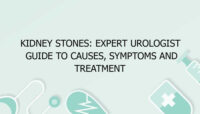Chronic Daily Headache (CDH) is a debilitating condition that affects a significant portion of the population. Characterized by the presence of headaches for 15 or more days per month over a three-month period, CDH can severely impact quality of life. Understanding the symptoms, diagnosis, and treatment options for Chronic Daily Headache is essential for effective management and relief.
Symptoms of Chronic Daily Headache
The term “Chronic Daily Headache” encompasses various headache disorders, but all share the common feature of frequent, recurring pain. Recognizing the specific symptoms is crucial for distinguishing CDH from other types of headaches.
- Persistent Pain: Chronic headaches often involve a consistent, daily pain pattern that can range from mild to severe.
- Tension-Type Characteristics: Many cases exhibit symptoms like a tight, band-like pressure around the head.
- Migraine Features: For some, CDH may include symptoms typical of migraines, such as throbbing pain, nausea, sensitivity to light and sound, or aura.
- Rebound Headaches: Medication overuse can lead to rebound headaches, exacerbating the frequency and intensity of pain.
- Neck and Shoulder Discomfort: Associated muscle tension can contribute to additional discomfort in these areas.
- Sleep Disturbances: Chronic headaches often interfere with restful sleep, perpetuating the cycle of pain.
Diagnosis of Chronic Daily Headache
Diagnosing Chronic Daily Headache involves a comprehensive evaluation to determine the underlying cause and rule out other conditions. Early and accurate diagnosis is critical for effective treatment.
- Medical History: A detailed patient history helps identify potential triggers, patterns, and duration of headaches. Information about medication use is also critical to address potential overuse.
- Physical Examination: A thorough neurological exam assesses reflexes, coordination, and signs of underlying issues like nerve damage or structural abnormalities.
- Imaging Tests: MRI or CT scans may be recommended to exclude conditions such as tumors, aneurysms, or infections that could cause persistent headaches.
- Headache Diary: Patients may be asked to document headache frequency, severity, and associated symptoms. This aids in identifying triggers and patterns.
- Blood Tests: Laboratory tests can detect infections, inflammation, or other systemic conditions linked to headache symptoms.
Treatment of Chronic Daily Headache
Managing Chronic Daily Headache requires a multifaceted approach tailored to individual needs. Effective treatment aims to reduce headache frequency and severity, improve quality of life, and address underlying causes.
- Lifestyle Modifications: Stress management, regular exercise, and a healthy diet play critical roles in preventing and alleviating headaches.
- Preventive Medications: Drugs like antidepressants, anticonvulsants, and beta-blockers are often prescribed to reduce headache frequency.
- Acute Pain Management: Nonsteroidal anti-inflammatory drugs (NSAIDs) or triptans may be used for immediate pain relief but must be monitored to avoid overuse.
- Behavioral Therapies: Techniques like cognitive-behavioral therapy (CBT), biofeedback, and relaxation exercises help manage stress and mitigate headache triggers.
- Physical Therapy: Targeted exercises strengthen neck and shoulder muscles, reducing tension that may contribute to headaches.
- Alternative Treatments: Acupuncture, yoga, and mindfulness meditation have shown promise in reducing headache severity and frequency.
- Addressing Medication Overuse: Gradual withdrawal of overused medications under medical supervision is crucial for managing rebound headaches.
Table: Chronic Daily Headache
| Aspect | Details |
|---|---|
| Common Symptoms | Persistent daily pain, tension-type characteristics, migraine-like features |
| Diagnostic Methods | Medical history, neurological exam, imaging tests, headache diary |
| Treatment Approaches | Lifestyle changes, preventive medications, behavioral therapies |
| Complications | Rebound headaches, sleep disturbances, reduced quality of life |
FAQs on Chronic Daily Headache
What is Chronic Daily Headache, and how does it differ from other headaches?
Chronic Daily Headache is not a single condition but a group of headache disorders characterized by headaches occurring 15 or more days per month for at least three months. Unlike episodic headaches, which occur sporadically, Chronic Daily Headache is persistent and frequent. It can encompass tension-type headaches, migraines, and rebound headaches caused by medication overuse. The defining factor is the frequency and regularity of the pain, which often necessitates a tailored, multidisciplinary treatment approach to address both symptoms and underlying causes.
What are the most common symptoms of Chronic Daily Headache?
The symptoms of Chronic Daily Headache vary but typically include daily or near-daily head pain, often described as a constant pressure or throbbing sensation. Some individuals experience symptoms similar to migraines, such as nausea, sensitivity to light and sound, or visual disturbances. Others report tension-type features, like a band-like tightness around the head. Sleep disturbances, fatigue, and neck or shoulder discomfort are also frequently associated with CDH, further complicating the condition.
How is Chronic Daily Headache diagnosed?
Diagnosing Chronic Daily Headache involves a comprehensive evaluation that starts with a detailed medical history to identify patterns, triggers, and medication use. A physical and neurological exam assesses overall health and detects potential underlying conditions. Imaging studies, such as MRI or CT scans, may be used to rule out structural abnormalities. Keeping a headache diary is often recommended to track the frequency, duration, and characteristics of headaches, which aids in confirming the diagnosis and tailoring treatment.
What causes Chronic Daily Headache?
The causes of Chronic Daily Headache are multifactorial, including genetic predisposition, medication overuse, and lifestyle factors. Stress, poor posture, and sleep disturbances are common contributors. Underlying conditions, such as hormonal imbalances, nerve disorders, or infections, can also trigger CDH. Identifying and addressing these causes is a crucial component of effective treatment, as it helps mitigate the frequency and severity of headaches.
Can lifestyle changes help manage Chronic Daily Headache?
Lifestyle changes are a cornerstone of Chronic Daily Headache management. Regular exercise, a balanced diet, and adequate hydration support overall health and reduce headache triggers. Stress management techniques, such as yoga, meditation, and relaxation exercises, are highly effective in alleviating tension and preventing headaches. Establishing a consistent sleep schedule and maintaining good posture further contribute to reducing the frequency and severity of Chronic Daily Headache episodes.
What role do medications play in treating Chronic Daily Headache?
Medications are a critical component of Chronic Daily Headache treatment. Preventive drugs, including antidepressants, anticonvulsants, and beta-blockers, are used to reduce headache frequency. Acute treatments, like NSAIDs or triptans, provide immediate relief but must be used cautiously to avoid rebound headaches. Addressing medication overuse through gradual withdrawal is essential for long-term success. A healthcare provider tailors the medication regimen based on individual needs and responses.
How does stress impact Chronic Daily Headache?
Stress is a significant trigger for Chronic Daily Headache, often exacerbating its frequency and intensity. Stress activates the body’s fight-or-flight response, leading to muscle tension, hormonal fluctuations, and changes in blood flow, all of which contribute to headache symptoms. Effective stress management through mindfulness, cognitive-behavioral therapy, or relaxation techniques is crucial in breaking the cycle of chronic headaches.
What are the risks of untreated Chronic Daily Headache?
Untreated Chronic Daily Headache can lead to a diminished quality of life, affecting personal, professional, and social aspects. Persistent pain often results in sleep disturbances, fatigue, and mood disorders, such as anxiety and depression. Rebound headaches from medication overuse further complicate the condition. Addressing Chronic Daily Headache early reduces the risk of long-term complications and improves overall well-being.
Are alternative treatments effective for Chronic Daily Headache?
Alternative treatments, such as acupuncture, yoga, and mindfulness meditation, have shown promising results in managing Chronic Daily Headache. These approaches help alleviate stress, improve circulation, and promote relaxation, contributing to reduced headache frequency and severity. While not a replacement for medical treatment, they serve as valuable complementary therapies in a comprehensive management plan.
Can Chronic Daily Headache be cured?
Chronic Daily Headache can often be managed effectively, though a complete cure may not always be possible. The goal of treatment is to reduce headache frequency and intensity, improve quality of life, and address underlying causes. A combination of lifestyle changes, medications, and therapies tailored to individual needs ensures the best outcomes. Ongoing collaboration with healthcare providers is essential for long-term success.
Table: Medical Journals on Chronic Daily Headache
| Journal Title | Description and Author |
|---|---|
| “Advances in Chronic Headache Management” | Comprehensive overview by Dr. Emily Carter on modern treatments for CDH. |
| “Neurobiology of Chronic Daily Headache” | In-depth exploration of underlying mechanisms by Dr. Michael Brown. |
| “Impact of Lifestyle on Headache Disorders” | Practical insights into lifestyle-based prevention by Dr. Rachel Green. |
| “Medication Overuse and Rebound Headaches” | Analysis of overuse impact by Dr. Laura Bennett. |
| “Behavioral Therapies for Chronic Pain” | Effectiveness of CBT and relaxation by Dr. Sarah White. |
| “Chronic Migraine and Tension-Type Headaches” | Comparative study by Dr. Amanda Hughes. |
| “Alternative Treatments for Headaches” | Evaluation of acupuncture and yoga by Dr. Helen Adams. |
| “Headache Diaries: A Diagnostic Tool” | Insights on diary use in diagnosis by Dr. Daniel Thompson. |
| “Sleep Disturbances in Chronic Headache” | Exploring the sleep-pain relationship by Dr. Susan Lee. |
| “Multidisciplinary Approaches to CDH” | Holistic management strategies by Dr. James Walker. |


